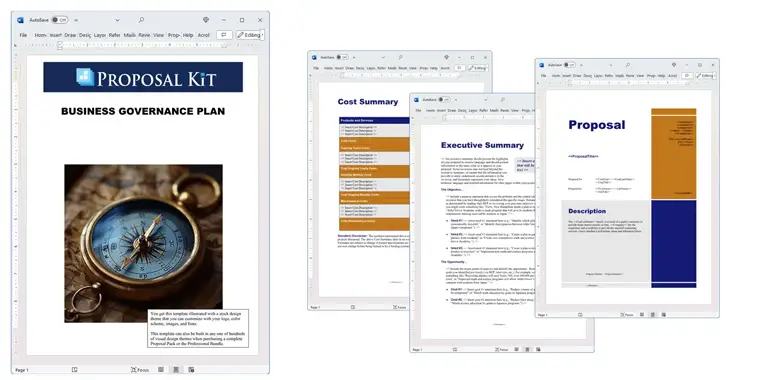How to write your Business Governance Plan
We include this 25 page layout with every Proposal Pack. If you want this template to have a different visual design theme than the one illustrated here, purchase any Proposal Pack design and create this template using the purchased design theme. This template is included in every Proposal Pack. If you get a Proposal Pack or the Professional Bundle, you can also make any variation of this template with different chapters to suit your needs.
We typically include more chapters in the templates than most people will need to give everyone more variety in the chapters they may need. You can trim down a long template by removing pages you do not need or combining multiple chapter topics into one page.
 DOWNLOADABLE, ONE-TIME COST, NO SUBSCRIPTION FEES
DOWNLOADABLE, ONE-TIME COST, NO SUBSCRIPTION FEES If you need this template on DVD media order from our Amazon shop.
If you need this template on DVD media order from our Amazon shop.
You can also create countless variations of this document to suit your needs using the included library of 2200+ chapters if ordering a Proposal Pack or Pro Bundle.
 What Our Clients Say
What Our Clients SayI love the Proposal Pack Wizard. I was able to create a 9 page document that looks absolutely fabulous. Without a doubt it will help in creating proposals. I’ll either be able to create them faster or if I take the same amount of time they will look much much better. This product is absolutely worth every last penny!"
Glenn Rathke
Related Article
Related Video
Related Templates
- Employee Handbook
- Human Resources Department Creation Proposal
- Human Resources Strategic Planning Proposal
- Human Resources Outsourcing Proposal
- Human Resources Training Services Proposal
- Company Operations Manual
- Strategic Plan
- Organizational Development Proposal
- Technology Strategy Analysis
- Strategic Plan for Mobilization and Deployment of Project
- Organizational and Managerial Structure Report
- Business Management Proposal
- Strategic Business Plan
- Strategic Business Map
The Best Way to Write a Business Governance Plan
For beginners, a proven approach is to use a structured template system. Proposal Kit offers a comprehensive range of templates tailored for governance plans. These templates guide the user through each section, ensuring all vital elements are addressed. The software also includes a line item quoting database system, aiding in the accurate compilation of financial aspects like cost summaries and budgets.
Trust and ethics are pillars that uphold an organization's integrity and reputation. A business governance plan is essential for addressing these critical issues. For those unfamiliar with writing such a plan, the task might seem overwhelming. However, with tools like Proposal Kit's template library and Wizard software program, this process becomes manageable and efficient. Proposal Kit is used to create many types of business documents, its not just for proposals.
Consider your organization's current stance on trust and ethics. Do you see the need for a structured plan to enhance governance in these areas?
What Types of Projects Are Business Governance Plans Written For?
Business governance plans can encompass a variety of projects, such as:
- Establishing a company-wide code of conduct.
- Developing an ethics compliance program.
- Implementing a whistleblower protection policy.
- Creating a conflict of interest policy.
- Setting up a corporate social responsibility (CSR) initiative.
- Formulating a data protection and privacy policy.
- Designing an employee training program on ethics and compliance.
- Developing a governance structure for board management.
- Establishing transparency measures for financial reporting.
- Implementing a sustainability strategy.
Chapters this template is built with
Proposal Kit's templates are instrumental in building a governance plan. There are thousands of chapter templates in the library you can pick from to cover any topic you need to talk about.
Each of these topics plays a vital role in creating a comprehensive business governance plan. They ensure that an organization not only establishes ethical guidelines and practices but also implements, monitors, and continuously improves them, fostering an environment of trust, accountability, and ethical integrity.
These templates are just a fraction of the thousands available in the Proposal Kit library, allowing for extensive customization.
Introduction
The Introduction of a business governance plan is crucial as it lays the foundation. It clearly defines the purpose of the plan, explaining why it is needed and what it aims to achieve. Additionally, it sets the scope, specifying the areas and functions within the organization that the plan will cover. This section is essential for aligning everyone's understanding and expectations about the governance initiatives.
SWOT Analysis
A SWOT Analysis in the context of business governance is a strategic tool used to assess the internal and external factors affecting governance practices. It involves identifying the Strengths (what the organization excels at in governance), Weaknesses (areas of governance that need improvement), Opportunities (external factors or trends the organization can capitalize on to improve governance), and Threats (external challenges that could affect governance practices).
Implementation Plan
The Implementation Plan details the actionable steps required to put governance policies into effect. It includes timelines, resource allocation, specific actions to be taken, and who is responsible for each action. This plan ensures that governance policies are not just theoretical concepts but are actively integrated into the organization's operations.
Relationship Management
This aspect focuses on how the organization manages its interactions with various stakeholders, including employees, shareholders, customers, and regulatory bodies. Effective relationship management is key to maintaining trust and ensuring that governance policies are understood and supported by all stakeholders.
Project Background
The Project Background provides context for the governance initiatives. It explains the events or circumstances that led to the need for these initiatives, the goals the organization aims to achieve, and how these initiatives align with the overall strategic objectives of the organization.
Responsibilities
This section defines the roles and responsibilities of different individuals and teams within the governance framework. It clarifies who is accountable for various aspects of governance, from policy development to implementation and enforcement, ensuring clear lines of responsibility.
Evaluation
Evaluation involves outlining how the organization will assess the effectiveness of its governance policies. This might include performance metrics, compliance audits, or feedback mechanisms. Regular evaluation helps to ensure that governance policies are working as intended and allows for continuous improvement.
Monitoring
Monitoring refers to the ongoing process of overseeing governance practices to ensure they are being followed and are effective. This could involve regular reviews, reporting systems, or compliance checks. Monitoring is essential for maintaining high standards of governance over time.
Accountability
Accountability is about setting up mechanisms to ensure individuals and teams are held responsible for their actions in relation to governance. This includes clear consequences for non-compliance and systems for reporting and addressing governance breaches.
Human Resources
The Human Resources section discusses how HR policies and practices support governance, such as through training programs on ethical behavior, compliance processes, and recruitment practices that emphasize integrity and ethical standards.
Leadership
Leadership plays a crucial role in setting the tone for governance. This section emphasizes the responsibility of leaders to model ethical behavior, make decisions that reflect the organization's governance standards, and foster a culture of transparency and accountability.
Code of Conduct
The Code of Conduct is a set of guidelines that outlines the ethical and professional standards expected of everyone in the organization. It serves as a reference point for acceptable behavior and decision-making.
Trust
Building and maintaining trust focuses on creating and sustaining positive relationships between the organization and its stakeholders. Trust is fundamental to effective governance and is built through consistent, ethical behavior and transparent communication.
Ethics
Ethics outlines the principles and values that guide the organization's operations. This section details the ethical standards the organization commits to upholding, such as honesty, fairness, and respect for stakeholders.
Reputation
Reputation management involves strategies to maintain and improve how the organization is perceived by the public and internal stakeholders. A strong, positive reputation is vital for an organization's success and is directly influenced by its governance practices.
Use cases for this template
Alex's Healthcare Governance Initiative
Alex, a small business owner in the healthcare industry, recognized the need for a robust business governance plan to ensure ethical practices and maintain patient trust. Facing the complexity of such a task, Alex turned to Proposal Kit. The software's templates helped him write a comprehensive plan that covered all aspects of healthcare governance, from patient confidentiality to employee conduct. The Implementation Plan and Ethics sections were particularly crucial in addressing industry-specific regulations and standards. Alex's successful implementation of this plan not only enhanced his organization's credibility but also improved overall patient care standards.
Jordan's HR Challenge
Jordan, an HR employee at a large corporation, was tasked with an urgent need to develop a business governance plan. The deadline was tight, and the stakes were high. Proposal Kit was his tool of choice, providing Jordan with a structured approach to tackle this challenge. By using the Human Resources and Leadership templates, Jordan could effectively align the governance plan with the company's culture and values. The Accountability and Code of Conduct templates were instrumental in defining clear guidelines for employee behavior. Jordan's adept use of Proposal Kit not only met the deadline but also set a new standard for governance in the company.
Taylor's Non-Profit Governance Quest
Taylor, a volunteer at an international non-profit, faced the task of creating a governance plan to guide staff conduct and uphold the organization's integrity. With limited resources and expertise in this area, Taylor utilized Proposal Kit. The Trust and Relationship Management templates enabled Taylor to write policies that fostered a culture of integrity and transparency within the organization. The Monitoring and Evaluation sections ensured that these policies were not only implemented but also continuously improved. Taylor's efforts led to a significant enhancement in the non-profit's governance, reinforcing its commitment to ethical practices.
Conclusions and Recommendations
In each of these stories, Proposal Kit proved to be an invaluable tool in developing and implementing business governance plans. From Alex's healthcare enterprise to Jordan's corporate role and Taylor's non-profit initiative, Proposal Kit facilitated the creation of comprehensive, effective governance strategies. These success stories exemplify how Proposal Kit can assist anyone, regardless of their experience level, in addressing critical issues of trust and ethics in their organization. By leveraging the power of Proposal Kit, businesses and organizations can enhance their governance structures, thus fostering a culture of integrity and ethical conduct, crucial for long-term success and reputation management.
Also Known As
This template may also be referred to in different ways or be used in more specialized situations, such as:
- Corporate Governance Framework
- Organizational Governance Strategy
- Enterprise Governance Model
- Business Oversight Plan
- Corporate Control Structure
- Operational Governance System
- Company Governance Policy
- Organizational Control Scheme
- Enterprise Management Protocol
- Corporate Regulation Blueprint
Abstract
 A business governance plan serves as a blueprint for companies to establish a framework ensuring good corporate governance, transparency, and ethical behavior. By implementing a business governance plan, organizations can align their corporate strategy with shareholder interests, promoting long-term value creation. These plans involve planning and robust corporate compliance programs, which are crucial for maintaining clear financial reporting and mitigating significant risks. Effective corporate governance requires a board of directors composed of competent board members, including independent directors, to oversee the execution of plans while balancing the best interests of the company's shareholders and other stakeholders.
A business governance plan serves as a blueprint for companies to establish a framework ensuring good corporate governance, transparency, and ethical behavior. By implementing a business governance plan, organizations can align their corporate strategy with shareholder interests, promoting long-term value creation. These plans involve planning and robust corporate compliance programs, which are crucial for maintaining clear financial reporting and mitigating significant risks. Effective corporate governance requires a board of directors composed of competent board members, including independent directors, to oversee the execution of plans while balancing the best interests of the company's shareholders and other stakeholders.
The core topics of a business governance plan include a well-defined code of conduct, data governance policies, and an audit committee to ensure compliance with relevant securities laws. This plan not only strengthens investor confidence but also attracts investors by safeguarding against bad corporate governance practices. A consensus-oriented leadership structure, supported by executive management, plays a vital role in fostering a corporate culture that prioritizes ethical decision-making and proactive risk management. Furthermore, the ongoing evaluation and monitoring of governance policies enable companies to adapt to regulatory changes and enhance board performance, thus minimizing financial loss and fulfilling fiduciary duties.
Companies must focus on good corporate governance practices to navigate the complexities of today's business environment. Strategic planning and corporate strategies are indispensable for addressing compliance concerns and steering the company's activities toward long-term growth. The involvement of audit committees and internal audits ensures clear financial reporting, offering equal consideration to shareholder interests and other stakeholders. Public companies, in particular, benefit from a governance plan that clearly defines the roles and responsibilities of board directors and emphasizes a diverse board composition to manage conflicts of interest.
 Informed decisions made by board tables and well-orchestrated operating plans contribute to the company's future and the broader community. By acting in accordance with good governance principles and focusing on ethical corporate behavior, organizations can manage governance-related conflicts and ensure compliance with the law. Companies must continually assess and adjust their governance frameworks to meet the challenges posed by market conditions and public opinion, thereby securing long-term value and maintaining the trust of major shareholders and public officials. In doing so, businesses not only fulfill their fiduciary duties but also serve the broader interests of society, contributing to sustainable progress and growth.
Informed decisions made by board tables and well-orchestrated operating plans contribute to the company's future and the broader community. By acting in accordance with good governance principles and focusing on ethical corporate behavior, organizations can manage governance-related conflicts and ensure compliance with the law. Companies must continually assess and adjust their governance frameworks to meet the challenges posed by market conditions and public opinion, thereby securing long-term value and maintaining the trust of major shareholders and public officials. In doing so, businesses not only fulfill their fiduciary duties but also serve the broader interests of society, contributing to sustainable progress and growth.
A comprehensive business governance plan is an important part of any organization's framework. It combines various topics of corporate behavior, data governance, and corporate compliance programs to create an environment where long-term value can be realized. By establishing a governance structure that includes board members and independent directors, a company ensures that all plans are aligned with the best interests of its shareholders. This structure is reinforced by clear financial reporting and a commitment to ethical decision-making, which are crucial for fostering a high degree of investor confidence and attracting new investments.
Such a plan also addresses the core topics of risk management, helping to mitigate significant risks and compliance concerns that could otherwise lead to financial loss. By setting up robust internal audit processes and audit committees, companies can detect potential governance issues early and implement action plans to resolve them. This proactive approach not only helps in meeting regulatory requirements but also enhances the efficiency of the company's operations, thereby maximizing shareholder value.
 Corporate leadership plays a role in directing the course of governance initiatives. Leaders are tasked with ensuring that governance policies are not just theoretical constructs but are actively employed across the organization. This requires a clear understanding of the company's vision and the ability to communicate it across all levels, ensuring that every member of the organization, from the CEO to operational managers, is aware of their responsibilities.
Corporate leadership plays a role in directing the course of governance initiatives. Leaders are tasked with ensuring that governance policies are not just theoretical constructs but are actively employed across the organization. This requires a clear understanding of the company's vision and the ability to communicate it across all levels, ensuring that every member of the organization, from the CEO to operational managers, is aware of their responsibilities.
In addition, a focus on diversity within board composition brings varied perspectives to the table, enabling more informed decisions that reflect the organization's commitment to equal consideration of all stakeholder interests. It also involves ongoing discussions and evaluations to adapt to regulatory changes, thus ensuring the organization's governance framework remains relevant and effective.
By fostering a culture of accountability and ethical standards, companies can improve their reputation and maintain a positive public opinion, which is just as important for ensuring long-term success. This involves not only adhering to securities laws and standards but also engaging with major shareholders and other stakeholders to build a broad consensus around governance initiatives. In doing so, organizations can fulfill their fiduciary duties and contribute positively to their communities, thus reinforcing their role as responsible corporate citizens.
 Ultimately, effective governance is not just about compliance and risk management; it's about creating a sustainable and ethical framework that guides the organization's growth and development. By implementing a well-structured business governance plan, companies can navigate the complexities of the business world with confidence, ensuring that they are well-positioned to capitalize on future opportunities while safeguarding against potential challenges.
Ultimately, effective governance is not just about compliance and risk management; it's about creating a sustainable and ethical framework that guides the organization's growth and development. By implementing a well-structured business governance plan, companies can navigate the complexities of the business world with confidence, ensuring that they are well-positioned to capitalize on future opportunities while safeguarding against potential challenges.
Frequently Asked Questions
What is the purpose of a business governance plan?
A business governance plan establishes the framework through which an organization is directed and controlled. It outlines the processes, practices, and policies that ensure the company operates legally, ethically, and transparently. This plan is essential for defining roles and responsibilities, managing risks, ensuring compliance with regulations, and safeguarding stakeholder interests, ultimately contributing to the long-term sustainability and success of the organization.
What should a business governance plan include?
A comprehensive business governance plan typically includes several key components: a clear statement of corporate governance principles, the roles and responsibilities of the board of directors and senior management, policies for risk management and internal controls, procedures for compliance and ethical conduct, mechanisms for stakeholder engagement, and a framework for performance evaluation and accountability. These elements help ensure the organization adheres to best practices and regulatory requirements while achieving its objectives.
How often should a business governance plan be reviewed and updated?
A business governance plan should be reviewed and updated regularly to ensure it remains relevant and effective in addressing the organization's needs and environment. Ideally, this review should occur annually or whenever there are significant changes in the business landscape, such as new regulations, shifts in market conditions, or internal changes like mergers or leadership transitions. Regular updates help the organization maintain robust governance practices and adapt to new challenges and opportunities.
Who is responsible for developing and maintaining the business governance plan?
The development and maintenance of a business governance plan is typically the board of directors' responsibility, often in collaboration with senior management. The board sets the governance framework and ensures it aligns with the organization's goals and regulatory requirements. Senior management usually implements the plan and oversees its day-to-day execution. The board and management should work together to ensure the plan is comprehensive, practical, and continuously improved.
How can a business governance plan improve organizational performance?
A well-written business governance plan can significantly enhance organizational performance by fostering a culture of accountability, transparency, and ethical behavior. It provides transparent decision-making and risk management guidelines, ensuring the organization operates efficiently and complies with legal and regulatory standards. Effective governance also builds trust among stakeholders, including investors, employees, and customers, which can lead to increased investment, employee morale, and customer loyalty. Organizations that establish robust governance practices are better positioned to achieve their objectives and sustain long-term success.
15% Off Discount
![]() Add To Cart This Word Template Only
Add To Cart This Word Template Only
 Add To Cart Proposal Pack for Any Business
Add To Cart Proposal Pack for Any Business
 Add To Cart Proposal Kit Professional Bundle
Add To Cart Proposal Kit Professional Bundle
 4.7 stars, based on 846 reviews
4.7 stars, based on 846 reviewsProposal Kit chapters used in this template
Cover Letter, Title Page, Table of Contents, Introduction, Executive Summary, Mission Statement, SWOT Analysis, Project Background, Leadership, Trust, Ethics, Reputation, Stakeholders, Code of Conduct, Officers and Board, Human Resources, Responsibilities, Implementation Plan, Relationship Management, Evaluation, Monitoring, Accountability, Conclusions, Recommendations, Back Page
Included Calculator Spreadheets
These Excel calculator spreadsheets are included with this template. If you purchase a Proposal Pack or the Professional Bundle, these proposal pages are generated using an automated line-item database in the included Wizard software. The calculator spreadsheets are intended for use when purchasing only the static Word template.
You use this proposal for
- General business proposal
- Project pitch proposal
- Internal company proposal
How to create this template with Proposal Pack Wizard
You can create this document using any of the logo-designed Proposal Packs. Pick any Proposal Pack with a logo design theme you like best; they will all work equally well. The Proposal Pack for Any Business is the pack with no extra added logos or colors - designed to be used plain or for you to customize with your logos and graphics.
The Proposal Pack design theme you purchase will determine the visual look of this template. The screenshot above only shows the plain generic design theme. Names and stories in examples are fictional; however, the templates are from real client use cases.
We include a library of chapters to be assembled based on your needs. All proposals are different and have different needs and goals. We designed Proposal Pack so you can customize the documents to suit your needs.
You will best create this document using the Proposal Pack Wizard - Expert Edition software to select this template and build it in the Proposal Pack logo design theme of your choice along with any desired customizations (such as adding additional chapters, removing unneeded chapters, changing the order of chapters, and importing your company logo). This template outlines a proposal for the described situation. Each user is responsible for typing in the actual content of the provided pages with their information to complete the proposal. Suggestions in the abstract may include features in higher-end packages and are facilitated by the selection of chapter templates to support the narrative of each proposal, which help guide the user in filling in the details.
You create this template using the Wizard software with an entire Proposal Pack library and software. We include the Expert Edition of the software in the Proposal Kit Professional bundle. Microsoft Word for Windows is required to use the customizing software. You can also edit Word document templates in other office software such as Word for Mac. We will assist Mac users in assembling complex templates for their first project if they do not have the required platform to run the Wizard software.
You only get the single assembled Word document if purchased as a stand-alone template. The individual template products include no other templates, samples, or software.
How to Build Templates Featured on Proposal Kit Website
Many people find the Proposal Kit website after searching for a specific proposal. Once you've purchased and installed the software, how do you build that template you found in the first place? This video shows you how to build any proposal you see on the Proposal Kit website.
Key Takeaways
- The Business Governance Plan is available as a ready-to-edit template.
- You can create unlimited custom variations of this template using a Proposal Pack or the Professional Bundle.
- Using a Proposal Pack or Professional Bundle, you can automate quotes and other financial pages with a line-item database.
- There are no ongoing subscription fees. You get lifetime unlimited use.
- We made Proposal Kit for freelancers, small businesses, and non-profits.
- Proposal Kit product content (templates, samples, software) is 100% written by humans.
 Ian Lauder has been helping businesses write their proposals and contracts for two decades. Ian is the owner and founder of Proposal Kit, one of the original sources of business proposal and contract software products started in 1997.
Ian Lauder has been helping businesses write their proposals and contracts for two decades. Ian is the owner and founder of Proposal Kit, one of the original sources of business proposal and contract software products started in 1997.By Ian Lauder
 Published by Proposal Kit, Inc.
Published by Proposal Kit, Inc.


 Cart
Cart


 Get 15% off ordering today:
Get 15% off ordering today: 

 Facebook
Facebook YouTube
YouTube X
X Search Site
Search Site